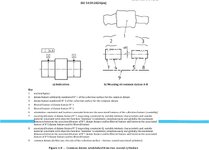greenimi
Mechanical
- Nov 30, 2011
- 2,391
Per ASME Y14.5-2018
7.12.4 Pattern of Features of Size RMB
When RMB is applicable in a feature control frame to common datum features of size used to establish a single datum, the true geometric counterpart of each feature shall be fixed in location relative to one another. The true geometric counterparts shall expand or contract simultaneously from their worst-case material boundary to their LMB until the true geometric counterparts make maximum possible contact with the extremities of the datum feature(s). When irregularities on the feature(s) may allow the part to be unstable, a single solution shall be defined to constrain the part.
Questions:
1.) What means maximum possible contact?
2.) What means "single solution" default for unstable/rocking datum features (that replaces the former default of a candidate datum set) ?
7.12.4 Pattern of Features of Size RMB
When RMB is applicable in a feature control frame to common datum features of size used to establish a single datum, the true geometric counterpart of each feature shall be fixed in location relative to one another. The true geometric counterparts shall expand or contract simultaneously from their worst-case material boundary to their LMB until the true geometric counterparts make maximum possible contact with the extremities of the datum feature(s). When irregularities on the feature(s) may allow the part to be unstable, a single solution shall be defined to constrain the part.
Questions:
1.) What means maximum possible contact?
2.) What means "single solution" default for unstable/rocking datum features (that replaces the former default of a candidate datum set) ?

